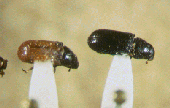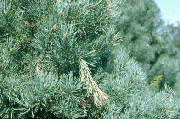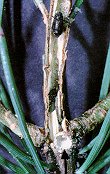DACF Home → Bureaus & Programs → Maine Forest Service → Forest Health & Monitoring → Forest Pest Index → Pine Shoot Beetle
PINE SHOOT BEETLE
Tomicus piniperda

Pine Shoot Beetle Adults
Photo: USDA Forest Service
Background Information
Name: The common pine shoot beetle Tomicus piniperda (L.) (PSB)
Native Range: Europe and Asia
Preferred Host (s): Scotch pine, Pinus sylvestris (L.)
Other Susceptible Hosts: Austrian, eastern white, red and jack pines

 Adult females lay their eggs between the inner bark and outer sapwood of cut stumps, logs or more rarely in trunks of severely weakened trees. Larvae develop within the stems and emerge as adults. These adults fly to the crowns of living, healthy trees and feed within the shoots. Each adult can kill 1-6 shoots during this period of feeding (usually lateral shoots within the upper crown). Natural spread by adults of over 1/2 a mile/year is possible. The major cause of long distance spread is through movement of infested trees and pine products
Adult females lay their eggs between the inner bark and outer sapwood of cut stumps, logs or more rarely in trunks of severely weakened trees. Larvae develop within the stems and emerge as adults. These adults fly to the crowns of living, healthy trees and feed within the shoots. Each adult can kill 1-6 shoots during this period of feeding (usually lateral shoots within the upper crown). Natural spread by adults of over 1/2 a mile/year is possible. The major cause of long distance spread is through movement of infested trees and pine products
Pine shoot beetle was first found in Ohio in 1992, it has since spread through the Great Lakes and northeastern North America. This insect was first recorded from Maine in 2000. There are low numbers of pine shoot beetle in scattered pockets of Franklin and Oxford Counties. Populations have not reached levels where damage is detectable.
USDA APHIS considers this to be a potentially serious pest – particularly in the southern US. For this reason PSB and its potential host materials are regulated. In Maine the pine shoot beetle quarantine area includes all counties except Aroostook and Washington.
Pest Alert: USDA Forest Service![]()
Quarantine
- Maine Forest Service Quarantine Page
- Maine Department of Agriculture Quarantine Rules
- APHIS PPQ Pine Shoot Beetle Web Page

MAINE DEPARTMENT OF AGRICULTURE, CONSERVATION AND FORESTRY
Maine Forest Service - Forest Health and Monitoring Division